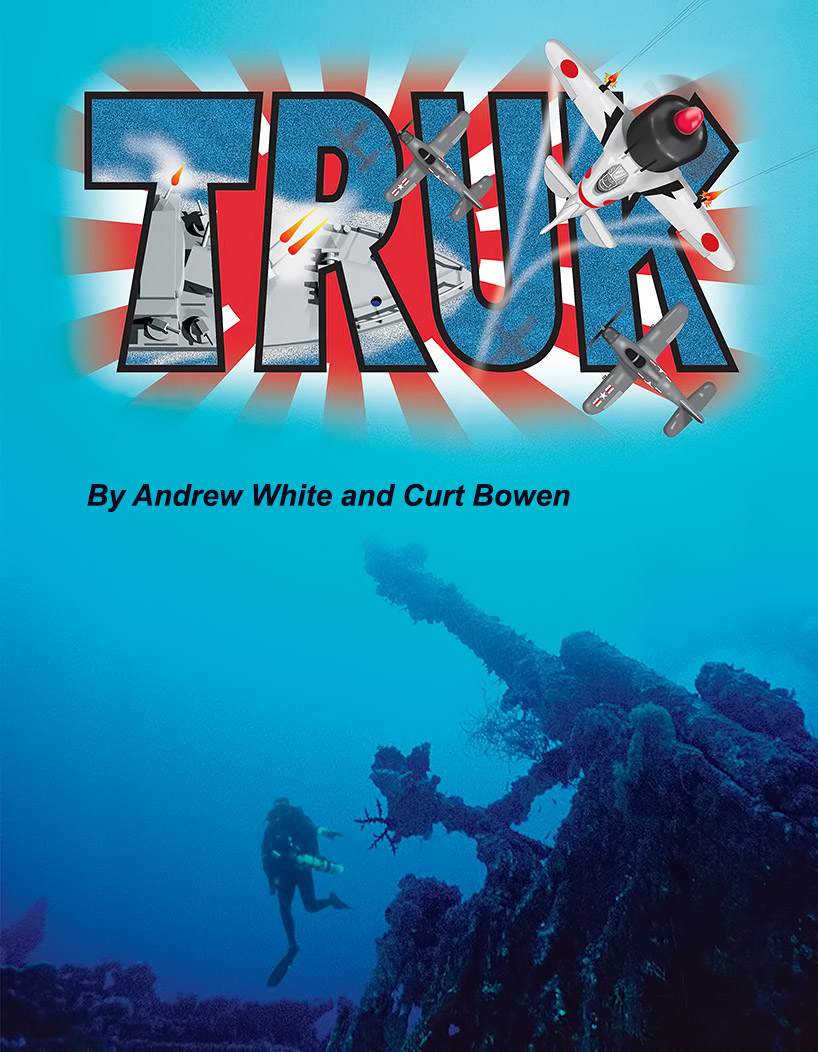

|
|
|
 |
| |
Above : Aikoku Maru’s stern antiaircraft gun still points towards the sky.
Photo: Wynn McCloskey |
| |
|
|
|
| |
In the Pacific Theater of World War II, the Japanese-held Truk Lagoon was regarded by Allied forces as an almost mystical fortress. This atoll deep behind enemy lines had a well- deserved reputation as being one of Japan's strongest holds in the Pa- cific. The area had been sealed off to outsiders for nearly 25 years, which led to uncertainty and near legend regarding its geography and the development of its defenses. The media of the time had fostered these myths of Truk referring to it in such terms as "Japan's impregnable bastion of the Pacific." As the leg- end grew, the Allies came to view the naval base at Truk with respect and more than a little fear.
In reality, Truk was one of Japan's most important naval bases. It occupied a strategic position in the West-Central Pacific, acted as a main fleet anchorage, and served as an advanced base for many Japanese naval operations. The combined Japanese fleet, including the super-battle- ships Yamato and Musashi often held up in Truk between missions. Japanese forces in the Solomon Islands and Guadalcanal used Truk Lagoon as a staging point and vital stop in the supply route between Pacific islands and the homeland. |
|
| |
 |
| |
Above: Japanese Tank sits silenced on the deck of the San Francisco Maru
Below: Ship mines and antiaircraft shells stacked in a ships hall.
|
| |
|
|
|
 |
| |
The geography of Truk made the perfect site for a naval base of the WW II era. The 40-mile diameter lagoon is encircled by shallow reef nearly 140 miles in circumference. At those distances, Japanese warships within the lagoon could stay outside the range of allied naval fire. The five navigable passes into the lagoon were strongly protected by artillery on flanking islands, and most were heavily mined. Navigation over the reef was impossible. Depths within the lagoon exceed 240 feet, providing plenty of mean water for ship and submarine navigation. Approximately 245 volcanic islands dot the lagoon, some with elevations in excess of 1500 feet. These islands were prime locations for airstrips, surface ship and submarine repair bases, troop barracks, bulk fuel storage, and radio communications. Most were heavily armed with antiaircraft weaponry.
While Truk had the potential to be one of the most formidable naval bases of the Pacific, Japanese losses at Midway and Coral Island had required them to spread their forces thin. By 1944 the tide of the war was turning and rising costs had dictated that Japan keep a large, mobile fleet. This forced them to cut back on armament required to properly defend Truk from a direct assault.
The naval base at Truk had long been a high priority target for the American military. In the early parts of 1944, fresh on the heels of victories in the nearby Marshall and Solomon islands, a realistic invasion plan of Truk was established. Named Operation Hailstone, the plan was to assemble a large, mobile striking force capable of advancing on Truk swiftly and unleashing an immense attack on the naval base. Similar to Japan's attack on Pearl Harbor, the assault on Truk would be swift and destructive. |
|
| |
 |
| |
Above: Large antiaircraft gun sits poised ready for allied invasion.
Below: Still locked to the decking this military transport vehicle is still fully loaded.
|
| |
|
|
|
 |
| |
The first look at Truk by American forces came on a reconnaissance mission by two marine aircraft. Flying at an altitude of 20,000 feet, these planes managed to photograph the naval base at Truk between breaks in the heavy cloud cover. They were detected by Japanese radar and only able to spend 20 minutes over the atoll, but the pictures they brought back provided valuable information to the American invasion force. There were more than 60 ships anchored within the lagoon at Truk. The photos also showed several air- strips and seaplane bases. The pieces were falling into place for an incredible air and sea battle.
On February 16, 1944 Allied forces merged on Truk Lagoon with 4 carriers, 6 light carriers, 7 battle- ships, 27 destroyers, 6 heavy cruisers, 5 light cruisers and an assortment of smaller support vessels. Amazingly, the fleet arrived undetected and in the early morning hours the battle began with an intense air assault. The Japanese were caught off guard. Though heavy resistance through the air was encountered by the Allied team, most of the warships that the marine flyers had photographed two weeks earlier had departed. What ensued was one of the fiercest air battles in history. |
|
| |
 |
| |
Above: Deep below deck in the far reaches of a ship’s hall ghostly human remains remind us of the consequences of war.
Below: Merchant ship’s gauges and telegraph encrusted with corals and sponges. |
| |
|
|
|
 |
| |
For two days the battle was waged, and when the smoke cleared it was a decisive victory for the Allies. Approximately 275 Japanese planes were destroyed or damaged, 45 Japanese ships had been sunk and another 26 had suffered damage. Most of these ships were merchantmen and auxiliary vessels, but several destroyers were counted among the casualties. Airstrips, fuel and ammunition supply depots, and repair stations were completely wiped out. The mighty naval base at Truk Lagoon had been neutralized. Allied losses during the battle were minuscule in comparison, with 25 planes having gone down and 29 pilots lost.
The Japanese never made a serious attempt to restore Truk to its former state of importance, however they held the atoll for nearly eighteen months after the initial raid. The Allies revisited Truk several times in that span, mostly in the form of high-altitude B-24 bombing raids. On September 2, 1945 the Japanese officially surrendered the island to Vice Admiral George Murray aboard the U.S.S. Portland, thus ending the reign of one of Japan's most formidable naval strongholds.
In 1947, Truk, along with all the Caroline Islands, were placed under a United Nations trusteeship that was administered by the United States. In 1979, it became a member of the United Federated States of Micronesia, where the islands are completely self-governing, but the United States is responsible for their defense. |
|
| |
 |
| |
 |
 |
| |
 |
|
|
|
| |
|